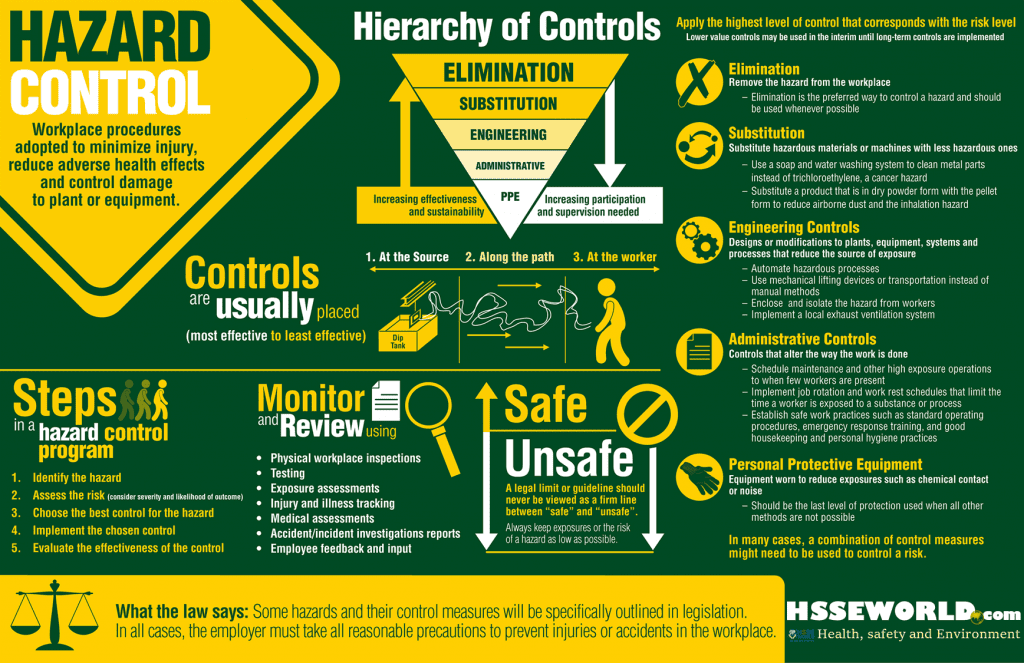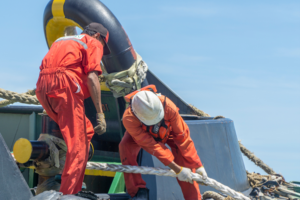Photo of the day: hierarchy of controls
9 min readThe hierarchy of control is a system for controlling risks in the workplace. Guidance on the photo of today explains the hierarchy of control and can help employers understand and use the hierarchy of control to eliminate or reduce risks at work.
What is the hierarchy of control?
The hierarchy of control is a system for controlling risks in the workplace. The hierarchy of control is a step-by-step approach to eliminating or reducing risks and it ranks risk controls from the highest level of protection and reliability through to the lowest and least reliable protection.

Eliminating the hazard and risk is the highest level of control in the hierarchy, followed by reducing the risk through substitution, isolation, and engineering controls, then reducing the risk through administrative controls. Reducing the risk through the use of protective personal equipment (PPE) is the lowest level of control.
The following element shows the structure of the hierarchy of control, from most effective control to least effective.
The hierarchy of control structure

1. Eliminate hazards and risks
Highest level of protection and most effective control.
Eliminating the hazard and the risk it creates is the most effective control measure.

2. Reduce the risk
Reduce the risk with one or more of the following controls:
- Substitution
Substitute the risks with lesser risks - Isolation
Isolate people from the risks - Engineering
Reduce the risks through engineering changes or changes to systems of work.

3. Administrative controls
Low level of protection and less reliable control.
Use administrative actions to minimize exposure to hazards and to reduce the level of harm.

4. Personal protective equipment
The lowest level of protection and least reliable control.
Use personal protective equipment to protect people from harm.
Employer duties
As an employer, you have a duty under the Occupational Health and Safety Act 2004 (OHS Act) to eliminate risks to health and safety, so far as is reasonably practicable. If it is not reasonably practicable to eliminate risks to health and safety, you must reduce those risks, so far as is reasonably practicable.
The hierarchy of controls helps employers fulfill their OHS Act responsibilities. In line with the OHS Act, the hierarchy of control first instructs employers to eliminate hazards and risks. If employers cannot eliminate hazards and risks, then they must work through the hierarchy and select controls that most effectively reduce the risk.
Reducing the risk may involve introducing a single risk control or a combination of two or more different controls. For example, protecting employees and others from flying debris when using a concrete cutting saw may involve isolating the work area, guarding the saw blade, and using PPE such as face shields.
When determining the most effective and reasonably practicable risk control, consider the time needed to introduce the control and whether it is necessary to introduce temporary risk control measures while preparing the preferred control. In some cases, it might be necessary to stop the activity until you can put an appropriate risk control measure in place.
The following steps, based on information from Safe Work Australia, explain each stage of the hierarchy of control, from most effective control measures to the least effective:
Using the hierarchy of control
1. Eliminate the risk
The most effective control measure involves eliminating the hazard and its associated risk. The best way to eliminate a hazard is to not introduce the hazard in the first place. For example, you can eliminate the risk of a fall from height by doing the work at ground level.
Eliminating hazards can be cheaper and more practical at the design or planning stage of a product, process, or workplace. In these early stages, there is more scope to design to eliminate hazards or to include risk control measures that are compatible with the requirements of the original design and function.
Employers can also eliminate hazards and risks by removing the hazard completely. For example, removing trip hazards on the floor or disposing of unwanted chemicals eliminates the risks they create.
It may not be possible to eliminate a hazard if doing so means you are unable to make the end product or deliver the service. If it is not possible to eliminate the hazard, then you must eliminate as many of the risks associated with the hazard as possible.
2. Reduce the risk through substitution, isolation or engineering controls
If it is not reasonably practicable to eliminate the hazards and associated risks, minimize the risks by:
Substitution
Substitute the hazard with something safer. For example:
- use a scourer, mild detergent and hot water instead of caustic cleaners for cleaning
- use a cordless drill instead of an electric drill if the power cord is in danger of being cut
- use water-based paints instead of solvent-based paints
Isolation
Isolate the hazard. For example:
- use concrete barriers to separate pedestrians and employees from powered mobile plant
- use remote controls to operate machines
- install guard rails around holes
Engineering controls
An engineering control is a control measure that is physical in nature, including a mechanical device or process. Examples of engineering controls include:
- mechanical devices such as trolleys or hoists to move heavy loads
- guards around moving parts of machinery
- pedestrian-sensing systems
- speed-governing mechanisms
3. Reduce the risk using administrative controls
Administrative controls are work methods or procedures designed to minimize exposure to a hazard. In most cases, administrative controls use systems of work to control the risk. For example:
- developing procedures on how to operate machinery safely
- limiting exposure time to a hazardous task
- using signs to warn people of a hazard
4. Reduce the risk of using personal protective equipment (PPE)
PPE refers to anything employees use or wear to minimize risks to their health and safety. PPE includes but is not limited to the following:
- ear muffs and earplugs
- goggles
- respirators
- face masks
- hard hats
- safety harnesses
- gloves
- aprons
- high-visibility clothing
- protective eyewear
- body suits
- safety footwear
- sunscreen
PPE limits exposure to the harmful effects of a hazard but only if employees wear and use the PPE correctly.
Using administrative controls and PPE to reduce risks does not control the hazard at the source. Administrative controls and PPE rely on human behavior and supervision and, used on their own, tend to be least effective in minimizing risks.
Use administrative controls and PPE only:
- as last resorts when there are no other practical control measures available
- as an interim measure until introducing a more effective way of controlling the risk
- to increase the effectiveness of higher-level control measures
Choose the most effective controls
Consider various control options and choose the controls that most effectively eliminate the hazard or, if elimination is not reasonably practicable, minimize the risk in the circumstances. Reducing the risk may involve a single control measure or a combination of different controls that work together to provide the highest level of reasonably practicable protection.
As an employer, you must consult your employees and their health and safety representatives (HSRs), if there are any when deciding on risk controls.
Safe Work Australia has provided much of the information on this page. See more advice on the hierarchy of controls from Safe Work Australia in Related Information, below.
( learn more:HIRA-HSE-hazards-effects-management-process-hemp-risk-register-template/).
Download Infographic
Hierarchy of controls
More photos
- What are the Best Practices for Managing Subcontractor Risk
- Photo of the day: 10 Essential Safety Tips for Driving in Hot Weather Conditions
- Photo of the day: best workplace safety tips
- Photo of the day: The Importance of Stop Work Authority in Maintaining Workplace Safety
- Photo of the day: Tomorrow’s Reward for Working Safely Today: Cultivating a Culture of Safety
- Photo of the day: Preventing slips and trips at work
- Photo of the day: Learn the DRSABCD action Plan
- Working with Electricity Electrical Accidents Guide for Electrical Workers
- Photo of the day: Hearing Protection Device Selection
- Photo of the day: If An Earthquake Shakes You-Infographic free
- Fire Safety Posters Free Download
- Photo of the day: First Aid for Electrical Burns-Infographic free
- Infographic: First Aid for Cuts and Scrapes free download
- Photo of The day: Work Safe with Lasers-Laser Safety free
- Photo of the day: Working Safely with chemicals and chemical Management
- Photo of the day: Safe work practices when using MEWPs ( updated)
- Photo of the day: Preventing Common Kitchen Hazards
- Photo of the day: Safe handling of Gas Cylinders and lecture bottles
- Photo of the day: Forklift Stability Triangle
- Photo of the day: Defective Tools Safe Work Practice
- Photo of the day: Lift With Your Legs Not With Your Back
- Photo of the day: First Aid for burns
- Photo of the day: The 7 Principles of HACCP
- Photo of the day: Working Safely with Suspended Loads
- Photo of the day: Heat Stroke First Aid and safety posters
- Photo of the day: Near-Miss Reporting and Posters
- Photo of the day: Ergonomic chair and office chair safety tips
- Photo of the day: Whole Body Vibration
- Photo of the day: Substation Safety Equipment
- Photo of the day: Bypassing Safety Controls Rules
- Photo of the day: Lightning Safety Tips
- Photo of the day: Overhead Power lines Clearance
- Photo of the day: Floor Marking
- Photo of the day: Types of Foot Protection
- Photo of the day: Types of Hand Protection
- Photo of the day: Lockout and Tagout Safety
- Photo of the day: Fall Protection Plans
- Photo of the day: Flood Safety Tips
- Photo of the day: Read All Labels Work safe
- Photo of the day: Run Project safely with Crane Hand Signals
- Photo of the day: Flagman and Traffic control
- Photo of the day: Managing Risks of Exposure to Solvents in the workplace
- Photo of the day: Scissor Lift Safety
- Photo of the day: HSE Bulletin Board
- Photo of the day: Arc-Fault Circuit Interrupters (AFCI)
- Photo of the day: Safe use of ladders and step ladders
- Photo of the day: Concrete Truck Driver Hand Signals
- Photo of the day: Extension Cord Safety Tips
- Photo of the day: Protect your Head
- Photo of the day: choosing the right Anchorage
- Photo of the day: Work-Related Asthma
- Photo of the day: Top FIVE Heavy Equipment Construction Site Safety Tips
- Photo of the day: sun safety in the workplace
- Photo of the day: Cannabis and Impairment in the Workplace
- Photo of the day: Position for safety and comfort-Safety Tips
- Photo of the day: Generator Safety
- Photo of the day: Controlling COVID-19 in the Workplace-Physical Barriers
- Photo of the day: Manual Material handling
- Photo of the day: Personal Protective Equipment last resort
- Photo of the day: WHMIS 2015 – Pictograms
- Photo of the day: Indoor Air Quality
- Photo of the day: Noise in the affected workplace
- Photo of the day: Fatigue at Work
- Photo of the day: Don’t be Driven to Distraction
- Photo of the day: working in heat and Humidex Rating
- How to use Plate Clamps Safely: Safety Moment#34
- Photo of the day: Sitting at work
- Photo of the day: 5 ways to reduce the risk of Slipping and Tripping
- Photo of the day: Preventing the spread of contagious illness
- Photo of the day: Incident Investigations
- Photo of the day: 10 Scaffold Safety Essentials
- Photo of the day: Effective Health and Safety Committees
- Photo of the day: New worker Orientation & Safety Orientation checklist
- Photo of the day: Workplace Inspection
- Photo of the day: musculoskeletal disorders
- Photo of the day: Emergency preparedness in the workplace
- Photo of the day: Mental health in the workplace
- Photo of the day: Trenching Safety Tips That Can Save a Life
- Photo of the day: Dangerous Goods Classes
- Photo of the day: Safety Equipment for Confined Spaces
- Photo of the day: Tips to reduce Heat stress in the workplace
- Photo of the day: hierarchy of controls
- Your steps to chemical safety
- H2S Gas and how to handle its Emergency
- Photo of the day: Importance of Mock drill and Fire Action Emergency Procedure
- Photo of the day: Choosing the Right Face Mask and the difference between a respirator and face mask
- Photo of the day: Confined space safety Precautions
- Breath Safely: The Proper Use of Respiratory Protection
- Photo of the day: Electric shock survival
- Photo of the day: Chemical Spill Emergency Response
- Photo of the day: Construction Site fire Safety
- Photo of the day: Confined Space rescue
- Photo of the day: Conveyors Safety Tips
- Photo of the day: 5 Essential outcomes of an effective leadership survey process
- Photo of the day: Safe Lifting at work
- Photo of the day: 5 Ways to Reinforce Commuting With Positive Reinforcement
- Photo of the day: Eyes on the Road The challenges of safe driving



